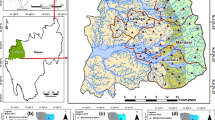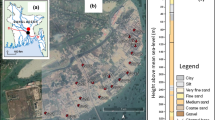Abstract
The geochemical study of groundwaters and core sediments from the Old Brahmaputra plain of Bangladesh was conducted to investigate the distribution of arsenic and related trace elements. Groundwaters from tube wells are characterized by pH of 6.4–7.4, dissolved oxygen (DO) of 0.8–1.8 mg/l, Ca contents of 5–50 mg/l, and Fe contents of 0.2–12.9 mg/l. Arsenic concentrations ranged from 8 to 251 μg/l, with an average value of 63 μg/l. A strong positive correlation exists between As and Fe (r 2 = 0.802; p = 0.001) concentrations in groundwater. The stratigraphic sequences in the cores consist of yellowish silty clays at top, passing downward into grayish to yellowish clays and sands. The uppermost 3 m and lower parts (from 13 to 31 m) of the core sediments are oxidized (average oxidation reduction potential (ORP) +170 and +220 mV, respectively), and the ORP values gradually become negative from 3 to 13 m depths (−35 to −180 mV), indicating that anoxic conditions prevail in the shallow aquifers of the Brahmaputra plain. Age determinations suggest that clay horizons at ~10 m depth were deposited at around 2,000 and 5,000 years BP (14C ages) during the transgressive phase of sea-level change. Elevated concentrations of As, Pb, Zn, Cu, Ni, Cr, and V are present in the silts and clays, probably due to adsorption onto clay particles. Significant concentrations of As occur in black peat and peaty sediments at depths between 9 and 13 m. A strong positive correlation between As and Fe was found in the sediments, indicating As may be adsorbed onto Fe oxides in aquifer sediments.







Similar content being viewed by others
References
Acharyya SK, Chakraborty P, Lahiri S, Raymahashay BC, Guha S, Bhowmik A (1999) Arsenic poisoning in the Ganges delta. Nature 401:545. doi:10.1038/44052
Acharyya SK, Lahiri S, Raymahashay BC, Bhowmik A (2000) Arsenic toxicity of groundwater in parts of the Bengal basin in India and Bangladesh: the role of Quaternary stratigraphy and Holocene sea-level fluctuation. Environ Geol 39:1127–1137. doi:10.1007/s002540000107
Ahmed KM, Bhattacharya P, Hasan MA, Akhter SH, Alam SMM, Bhuyian MAH, Imam MB, Khan AA, Sracek O (2004) Arsenic enrichment in groundwater of the alluvial aquifers in Bangladesh: an overview. Appl Geochem 19:181–200. doi:10.1016/j.apgeochem.2003.09.006
Akai J, Izumi K, Fukuhara H (2003) Bacterial activities as a key role in arsenic contaminations of groundwater suggested by geo-microbial experiments using lake sediments. In: International symposium on bio-mineralization, Japan, pp 12–17
Akai J, Izumi K, Fukuhara H, Masuda H, Nakano S, Yoshimura T, Ohfuji H, Anawar HM, Akai K (2004) Mineralogical and geomicrobiological investigations on groundwater arsenic enrichment in Bangladesh. Appl Geochem 19:215–230. doi:10.1016/j.apgeochem.2003.09.008
Anawar HM, Komaki K, Akai J, Takada J, Ishizuka T, Takahashi T, Yoshioka T, Kato K (2002) Diagenetic control on arsenic partitioning in sediments of the Meghna River delta, Bangladesh. Environ Geol 41:816–825. doi:10.1007/s00254-001-0459-x
Anawar HM, Akai J, Komaki K, Terao H, Yoshioka T, Shizuka T, Safiullah S, Kato K (2003) Geochemical occurrence of arsenic in groundwater of Bangladesh: sources and mobilization processes. J Geochem Explor 77:109–131. doi:10.1016/S0375-6742(02)00273-X
Ayyamperumal T, Jonathan MP, Srinivasalu S, Armstrong-Altrin JS, Ram-Mohan V (2006) Assessment of acid leachable trace metals in sediment cores from River Uppanar, Cuddalore, Southeast coast of India. Environ Pollut 143:34–45. doi:10.1016/j.envpol.2005.11.019
BGS and DPHE (2001) Arsenic contamination of groundwater in Bangladesh, vol 2. Final report, BGS Technical Report WC/00/19, 267 pp
Bhattacharyya R, Jana J, Nath B, Sahu S, Chatterjee D, Jacks G (2003) Groundwater arsenic mobilization in the Bengal Delta Plain, the use of ferralite as a possible remedial measure—a case study. Appl Geochem 18:1435–1451
Brammer H (1996) The geography of the soils of Bangladesh. University Press Ltd, Dhaka, p 287
Chowdhury TR, Basu GK, Mandal BK, Biswas BK, Samanta G, Chowdhury UK, Chanda CR, Lodh D, Roy SL, Saha KC, Roy S, Kabir S, Quamruzzaman Q, Chakraborti D (1999) Arsenic poisoning in the Ganges delta. Nature 401:545–546
Dhar RK, Biswas BK, Samanta G, Mandal BK, Chakraborty D, Roy S, Jafar A, Islam A, Ara G, Kabir S, Khan AW, Ahmed SA, Hadi SA (1997) Groundwater arsenic calamity in Bangladesh. Curr Sci 73(1):48–59
Fabian D, Zhou Z, Wehrli B, Friedl G (2003) Diagenetic cycling of arsenic in the sediments of eutrophic Baldeggersee, Switzerland. Appl Geochem 18:1497–1506
Gaillard J-F (1994) Early diagenetic modeling: a critical need for process studies, kinetic rates, and numerical methods. Trends Chem Geol 1:239–252
Garcia-Sanchez A, Alvarez-Ayuso E (2003) Arsenic in soils and waters and its relation to geology and mining activities (Salamanca Province, Spain). J Geochem Explor 80:69–79
Guern CL, Baranger P, Crouzet C, Bodénan F, Conil P (2003) Arsenic trapping by iron oxyhydroxides and carbonates at hydrothermal spring outlets. Appl Geochem 18:1313–1323
Huerta-Díaz MA, Tessier A, Carignant R (1998) Geochemistry of trace metals associated with reduced sulfur in freshwater sediments. Appl Geochem 13:213–233
Ishiga H, Dozen K, Yamazaki C, Ahmed F, Islam MB, Rahman MH, Sattar MA, Yamamoto H, Itoh K (2000) Geological constraints on arsenic contamination of groundwater in Bangladesh. In: Proceedings of the 5th international forum on arsenic contamination of groundwater in Asia, Asia Arsenic Network, Yokohama, Japan, pp 53–62
Manning BA, Goldberg S (1997) Adsorption and stability of As (III) at the clay mineral-water interface. Environ Sci Technol 31:2005–2011
Markgraf V (1989) Palaeoclimates in central and South America since 18,000 BP based on pollen and lake level-records. Quatern Sci Rev 8(1):1–24
McArthur JM, Ravenscroft P, Safiullah S, Thirlwall MF (2001) Arsenic in groundwater: testing pollution mechanisms for sedimentary aquifers in Bangladesh. Water Resour Res 37:109–117
McArthur JM, Banerjee DM, Hudson-Edwards KA, Mishra R, Purohit R, Ravenscroft P, Cronin A, Howarth RJ, Chatterjee A, Talukder T, Lowry D, Houghton S, Chadha DK (2004) Natural organic matter in sedimentary basins and its relation to arsenic in anoxic groundwater: the example of West Bengal and its worldwide implications. Appl Geochem 19:1255–1293
Millward GE, Moore RM (1982) The adsorption of Cu, Mn and Zn by iron oxyhydroxides in model estuarine solutions. Water Res 16:981–985
Monsur MH (1990) Stratigraphical and palaeomagnetical studies of some quaternary deposits of the Bengal Basin, Bangladesh. Doctoral dissertation, Free University of Brussels, Belgium, 241 pp
Mukherjee AB, Bhattacharya P (2001) Arsenic in groundwater in the Bengal Delta Plain: slow poisoning in Bangladesh. Environ Rev 9:189–220
Nickson RT, McArthur JM, Burgess WG, Ahmed KM, Ravenscroft P, Rahman M (1998) Arsenic poisoning of Bangladesh groundwater. Nature 395:338
Nickson RT, McArthur JM, Ravenscroft P, Burgess WG, Ahmed KM (2000) Mechanism of arsenic release to groundwater, Bangladesh and West Bengal. Appl Geochem 15:403–413
Nickson RT, McArthur JM, Shrestha B, Kyaw-Myint TO, Lowry D (2005) Arsenic and other drinking water quality issues, Muzaffargarh district, Pakistan. Appl Geochem 20:55–68
Ogasawara M (1987) Trace element analysis of rock samples by X-ray fluorescence spectrometry, using Rh anode tube. Bull Geol Surv Jpn 38(2):57–68
Padmalal D, Maya K, Seralathan P (1997) Geochemistry of Cu, Co, Ni, Zn, Cd and Cr in the surficial sediments of a tropical estuary, southwest coast of India: a granulometric approach. Environ Geol 31(1–2):85–93
Peltier EF, Webb SM, Gaillard JF (2003) Zinc and lead sequestration in an impacted wetland system. Adv Environ Res 8:103–112
Potts PJ, Tindle AG, Webb PC (1992) Geochemical reference material compositions. Whittles Publishing, Caithness, p 313
Preda M, Cox ME (2002) Trace metal occurrence and distribution in sediments and mangroves, Pumicestone region, southeast Queensland, Australia. Environ Int 28:433–449
Ravenscroft P, McArthur JM, Hoque BA (2001) Geochemical and palaeohydrological controls on pollution of groundwater by arsenic. In: Chappell WR, Abernathy CO, Calderon R (eds) Arsenic exposure and health effects IV. Elsevier, Oxford, pp 53–77
Rudnick RL (2005) The crust. In: Holland HD, Turekian KK (eds) Treatise on geochemistry, vol 3. Elsevier, Oxford, p 537
Singh M, Sharma M, Tobschall HJ (2005) Weathering of the Ganga alluvial plain, northern India: implications from fluvial geochemistry of the Gomati River. Appl Geochem 20:1–21
Smedley PL, Kinniburgh DG (2002) A review of the source, behavior and distribution of arsenic in natural waters. Appl Geochem 17:517–568
Sullivan KA, Aller RC (1996) Diagenetic cycling of arsenic in Amazon shelf sediments. Geochim Cosmochim Acta 60(9):1465–1477
Tareq SM, Safiullah S, Anawar HM, Rahman MM, Ishizuka T (2003) Arsenic pollution in groundwater: a self-organizing complex geochemical process in the deltaic sedimentary environment, Bangladesh. Sci Total Environ 313:213–226
Taylor SR, McLennan SM (1985) The continental crust: its composition and evolution. Blackwell, Oxford, p 312
Tessier A, Carignan R, Belzile N (1994) Processes occurring at the sediment-water interface: emphasis on trace elements. In: Buffle J, DeVitre RR (eds) Chemical and biological regulation of aquatic system. Lewis Publishers, Boca Raton, pp 137–173
Tribovillard NP, Desprairies A, Verges EL, Bertrand P, Moureau N, Ramdani A, Ramanampisoa L (1994) Geochemical study of organic-matter rich cycles from the Kimmeridge Clay Formation of Yorkshire (UK): productivity versus anoxia. Palaeogeogr Palaeoclimatol Palaeoecol 108:165–181
Umitsu M (1985) Natural levees and landform evolutions in the Bengal Lowland. Geogr Rev Jpn Ser B 58:149–164
Umitsu M (1993) Late quaternary sedimentary environments and landforms in the Ganges delta. Sed Geol 83:177–186
WHO (World Health Organization) (2004) Guidelines for drinking-water quality recommendations, vol 1. WHO, Geneva, p 515
Yamazaki C, Ishiga H, Dozen K, Higashi N, Ahmed F, Sampei Y, Rahman MH, Islam MB (2000) Geochemical composition of sediments of the Ganges delta of Bangladesh-arsenic release from the peat? Earth Sci (Chikyu Kagaku) 54:81–93
Yamazaki C, Ishiga H, Ahmed F, Itoh K, Suyama K, Yamamoto H (2003) Vertical distribution of arsenic in Ganges delta sediments in Deuli village, Bangladesh. Soil Sci Plant Nutr 49(4):567–574
Yan X-P, Kerrich R, Hendry MJ (2000) Distribution of arsenic (III), arsenic (V) and total inorganic arsenic in porewaters from a thick till and clay-rich aquitard sequence, Saskatchewan, Canada. Geochim Cosmochim Acta 62(15):2637–2648
Zheng Y, Stute M, van Geen A, Gavrieli I, Dhar R, Simpson HJ, Schlosser P, Ahmed KM (2004) Redox control of arsenic mobilization in Bangladesh groundwater. Appl Geochem 19:201–214
Acknowledgments
The authors thank Professor Yoshikazu Sampei and Professor Yoshihiro Sawada of Shimane University for access to the AAS and XRF facilities, and Professor M. A. Sattar of Bangladesh Agricultural University, Mymensingh, Bangladesh, for his cooperation in sampling. We thank the Mymensingh City Authority for their valuable support during sample collection. The radiocarbon dating was carried out at Nagoya University, Japan.
Author information
Authors and Affiliations
Corresponding author
Rights and permissions
About this article
Cite this article
Ahmed, F., Bibi, M.H., Ishiga, H. et al. Geochemical study of arsenic and other trace elements in groundwater and sediments of the Old Brahmaputra River Plain, Bangladesh. Environ Earth Sci 60, 1303–1316 (2010). https://doi.org/10.1007/s12665-009-0270-7
Received:
Accepted:
Published:
Issue Date:
DOI: https://doi.org/10.1007/s12665-009-0270-7




